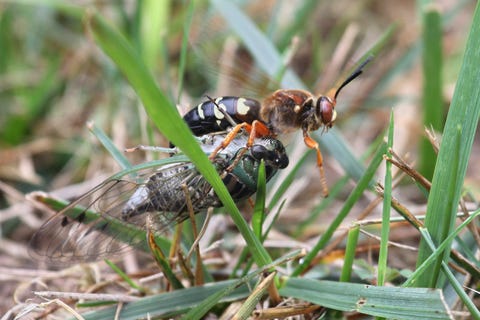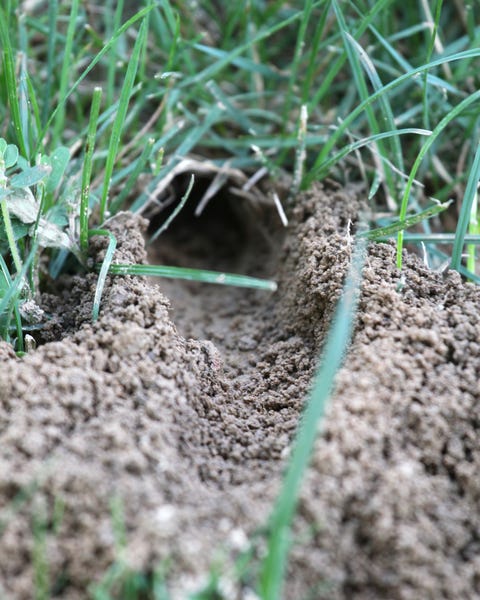How to Get Rid of Paper Wasp Nest
Earlier this year, the U.S. was introduced to murder hornets, fierce predators that can decapitate an entire honey bee hive in hours. But these rare, invasive insects (which have only been spotted in select areas of the west coast) are increasingly becoming confused with another freaky flyer that looks eerily similar due to its size: cicada killer wasps.
As their name implies, cicada killers like to take out and feast on cicadas, those really loud, bulbous-eyed bugs that come out from mid-to-late summer.
Cicada killers are intimidating because they're much larger than the average wasp, but they aren't as dangerous as they may look. Here's what you need to know about cicada killer wasps, plus how to get rid of them if you rather not have them buzzing about.
What are cicada killer wasps?
Cicada killer wasps have big stingers designed to plunge into cicadas and paralyze them. They're also known as "digger wasps," says Philip Koehler, Ph.D., a professor and researcher in the Department of Entomology and Nematology at the University of Florida. "They're solitary and dig holes in the ground to hide the paralyzed insects that they catch," he explains.
In fact, these wasps can fly while carrying a cicada that's equal to or heavier than its own weight, says Howard Russell, M.S., an entomologist at Michigan State University.
Female cicada killers aren't considered aggressive and don't tend to be defensive of their nests, Koehler says, even though "they can be quite large and kind of scary."
What do cicada killer wasps like to eat?

chiptape Getty Images
As the name suggests, "these wasps prey on cicadas," explains Ben Hottel, Ph.D., technical services manager at Orkin, LLC. "They do so by grabbing a cicada from the branches of a tree and stinging it to immobilize it. They then carry it back to the hole it has made in the soil to feed their young." The adults typically feast on flower nectar and other insects.
An interesting-but-gross fact about these wasps: A female cicada killer will bury a cicada in the ground and lay its eggs on top. "Once the wasp egg hatches, which takes two to three days, it burrows into the cicada, consumes it from the inside out, and then pupates in the shell of the cicada," says Marc Potzler, a board-certified entomologist and technical services manager at Ehrlich Pest Control.
Do cicada killer wasps sting humans?
A female cicada killer can sting, but again, they're not incredibly aggressive. Koehler says that "people do get stung if they pick one up. It will defend itself."
If you happen to get stung by a female, just know that it likely won't hurt as much as a sting from other insects. "Their stings produce a very mild venom that is far less painful than the sting of many social wasps, like yellow jackets," Hottel says.
Plus, most of the cicada killers you'll actually see is a male trying to protect the nesting area. It might fly around you or get in your face—but it's all for show. A male cicada killer cannot sting.
How are cicada killers different from murder hornets?
Cicada killer wasps do look a lot like murder hornets, so the confusion is understandable. Murder hornets have a yellow-orange face, a black and yellow striped abdomen, and tend to be between 1.5 to 2 inches in length, according to Washington State University. Cicada killers tend to be up to 2 inches long, with a black and yellow abdomen and brownish wings, Koehler says.
The biggest difference between these two is that murder hornets are very aggressive and dangerous insects (their toxic sting is known to kill), while female cicada killers generally leave people alone unless mishandled.
How to get rid of cicada killer wasps

chiptape Getty Images
If you can live with oversized wasps buzzing around your home, Koehler points out that they tend to be beneficial and take out other insects. Still, they do have a tendency to dig and form large tunnels along sidewalks and patio edges, and in flower beds, gardens, and lawns, which can result in damage.
If you understandably don't want them around for this reason, Koehler recommends applying an insecticidal dust, like 5% carbaryl dust, in and around the burrow entrance to try to kill them (just make sure the product is safe to use on turf). Keep the entrance to the tunnel open so the wasp can go back into the area treated with the dust.
If that doesn't work or you're dealing with a large amount of tunnels, it's time to call a professional. "They will keep coming back year after year if they like the soil structure, so get your pest management professional to come out and treat the area," Potzler says.
Support from readers like you helps us do our best work. Go here to subscribe to Prevention and get 12 FREE gifts. And sign up for our FREE newsletter here for daily health, nutrition, and fitness advice.
Korin Miller Korin Miller is a freelance writer specializing in general wellness, sexual health and relationships, and lifestyle trends, with work appearing in Men's Health, Women's Health, Self, Glamour, and more.
This content is created and maintained by a third party, and imported onto this page to help users provide their email addresses. You may be able to find more information about this and similar content at piano.io
How to Get Rid of Paper Wasp Nest
Source: https://www.prevention.com/life/a33585701/cicada-killer-wasps/